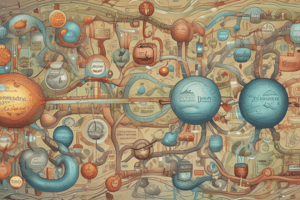Podcast
Questions and Answers
What is the difference between anabolism and catabolism in metabolism?
What is the difference between anabolism and catabolism in metabolism?
Anabolism involves the synthesis of molecules from simpler precursors with a net energy consumption, while catabolism involves the degradation of molecules to simpler precursors with a net energy release.
How can carbohydrates like glucose be utilized in metabolic pathways to produce energy?
How can carbohydrates like glucose be utilized in metabolic pathways to produce energy?
Carbohydrates like glucose can undergo glycolysis to produce ATP and high-energy carrier NADH, leading to the generation of acetyl-CoA in the presence of oxygen.
What is the main function of acetyl-CoA in metabolism?
What is the main function of acetyl-CoA in metabolism?
Acetyl-CoA can enter the Krebs cycle, producing high-energy carriers like NADH and FADH2 for ATP production.
How are triglycerides broken down in the body for energy production?
How are triglycerides broken down in the body for energy production?
What happens to proteins from the diet in metabolic pathways?
What happens to proteins from the diet in metabolic pathways?
Give an example of a reversible metabolic pathway mentioned in the text.
Give an example of a reversible metabolic pathway mentioned in the text.
How is acetyl-CoA involved in the synthesis of fatty acids?
How is acetyl-CoA involved in the synthesis of fatty acids?
¿Cuál es la diferencia principal entre anabolismo y catabolismo en el metabolismo?
¿Cuál es la diferencia principal entre anabolismo y catabolismo en el metabolismo?
¿Cómo se convierte la glucosa en moléculas energéticas como ATP y NADH?
¿Cómo se convierte la glucosa en moléculas energéticas como ATP y NADH?
¿Qué proceso convierte el piruvato en acetil CoA y qué se necesita para que esto ocurra?
¿Qué proceso convierte el piruvato en acetil CoA y qué se necesita para que esto ocurra?
¿Cuál es la composición de los triglicéridos y cómo pueden ser utilizados para la producción de energía?
¿Cuál es la composición de los triglicéridos y cómo pueden ser utilizados para la producción de energía?
¿Cómo pueden las proteínas de la dieta ser utilizadas en rutas metabólicas?
¿Cómo pueden las proteínas de la dieta ser utilizadas en rutas metabólicas?
¿Qué determina si el piruvato sigue hacia el ciclo de Krebs o entra en fermentación en ausencia de oxígeno?
¿Qué determina si el piruvato sigue hacia el ciclo de Krebs o entra en fermentación en ausencia de oxígeno?
¿Qué tipo de procesos metabólicos son reversibles y cuál es un ejemplo mencionado en el texto?
¿Qué tipo de procesos metabólicos son reversibles y cuál es un ejemplo mencionado en el texto?
¿Por qué la conversión de acetil CoA en piruvato es un proceso irreversible en el metabolismo?
¿Por qué la conversión de acetil CoA en piruvato es un proceso irreversible en el metabolismo?
Study Notes
- Metabolism consists of anabolism (synthesis of molecules from simpler precursors with a net energy consumption) and catabolism (degradation of molecules to simpler precursors with a net energy release).
- Macronutrients like lipids, carbohydrates, and proteins can be targeted by both anabolic and catabolic pathways.
- Carbohydrates like glucose can undergo glycolysis to produce ATP and high-energy carrier NADH, leading to the generation of acetyl-CoA in the presence of oxygen.
- Acetyl-CoA can enter the Krebs cycle, producing more high-energy carriers like NADH and FADH2, which can then donate electrons in the electron transport chain for ATP production.
- Triglycerides, the main energy reserve in the body, can be broken down through beta-oxidation into acetyl-CoA for the Krebs cycle to generate more high-energy carriers.
- Proteins from the diet can be broken down into amino acids, which can either be used to build new proteins or enter metabolic pathways like gluconeogenesis or conversion to acetyl-CoA.
- Many metabolic pathways are reversible or interconnected, such as gluconeogenesis converting pyruvate back to glucose or acetyl-CoA being used for fatty acid synthesis.
Studying That Suits You
Use AI to generate personalized quizzes and flashcards to suit your learning preferences.
Description
Test your knowledge on the metabolic processes of anabolism and catabolism, including the synthesis and degradation of macronutrients like lipids, carbohydrates, and proteins. Learn about key pathways such as glycolysis, Krebs cycle, beta-oxidation, and gluconeogenesis.




